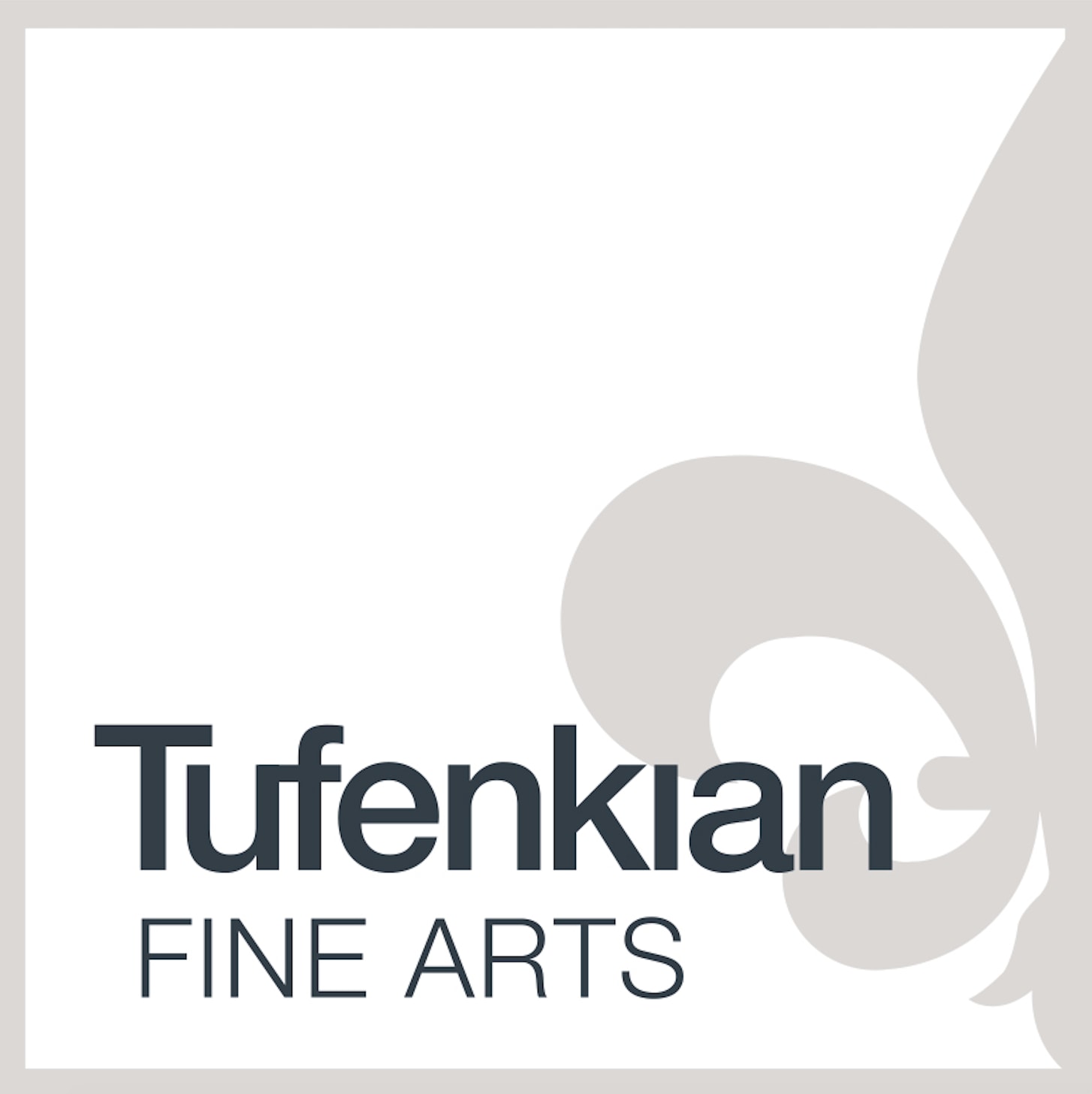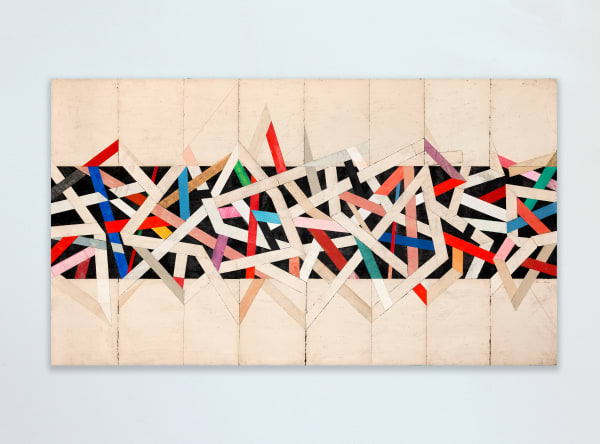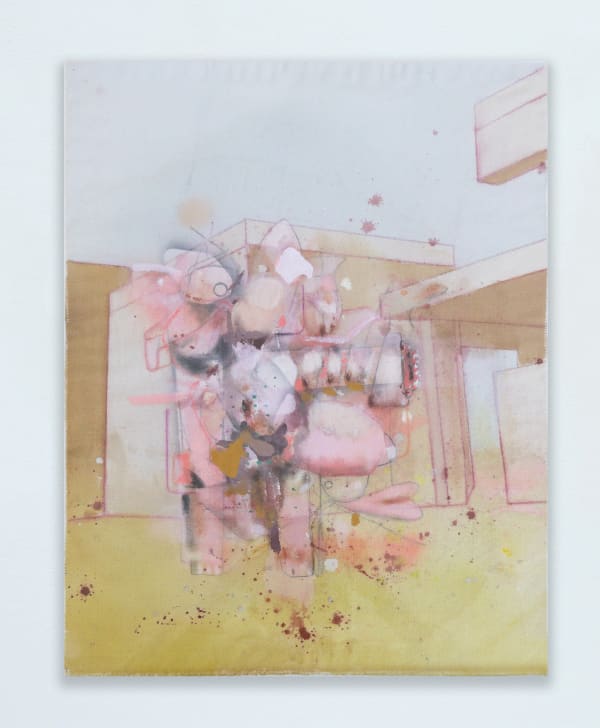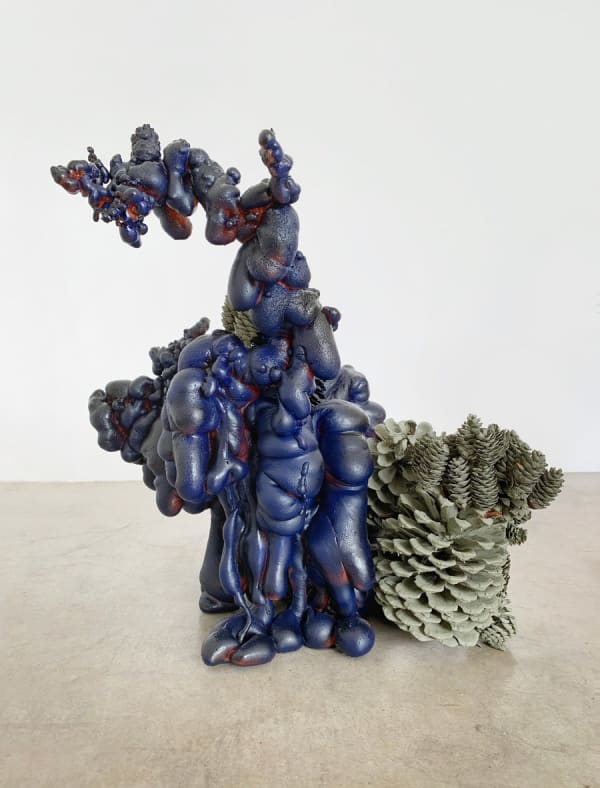The Fabric of Memory
Tufenkian Fine Arts is pleased to announce, The Fabric of Memory, a group exhibition featuring a selection of recent paintings and sculptures by Carlos Beltran-Arechiga, Sam Grigorian, Carolyn Mason, Luis Moreno, and Gretel Stephens. This exhibition will be on view from March 4th through April 22nd, 2023, with an opening reception to be held at the gallery on Saturday, March 4th from 3:00 pm to 6:00 pm.
The artists in The Fabric of Memory share a visual lexicon that emphasizes raw aesthetic elements, biological and organic structures, as well as the use of discarded and found materials. The overlapping aesthetics of the works in this exhibition demonstrate the breadth and dexterity of these artists’ practices: densely layered and collaged paintings, pared down canvases, and sculptures that explore the use of texture, structure, and coloration. The Fabric of Memory aims to depict the underlying psyches and rooted experiences of these artists through their assemblage of carefully considered choice materials.
Carlos Beltran-Arechiga paints implied and explicit structures which question the arrangement of the systems and policies that determine access and equity. Beltran-Arechiga uses his paintings to confront the promise of the “American Dream” and the “Promised Land” in a state of chaos and order; desolate and fertile. As a first generation Mexican-American immigrant, the artist populates his canvases with edifices that are meant to evoke the archetypal homes affirmed by the legacy of the “American Dream.” Using drop cloth as the canvas for these works, the artist memorializes the material’s accumulated construction stains, reflecting on the idea of how those who contribute to the sustainment of pre-established systems may not necessarily be designed by or for them.
Although incidental references to notational factors such as writing and musical notation recur in his work, Sam Grigorian is principally interested in texture, structure, and muted coloration. Grigorian’s material of choice is paper, and by folding, bending, crushing, ripping, scraping, plastering it, and painting over it, only to tear strips out of it again, he is able to achieve a relatively uniform (if still vital) “skin” on the canvas. Grigorian’s Armenian roots become visible through his special relation to paper, which he makes by hand before using it. As the artist strips back layers on the canvas, enigmatic signs begin to appear. These newly arranged signs become elements of a coded language of personal marks blended together with emblems of traditional symbols, making the loss of the oral tradition in the Armenian diaspora visible and tangible.
Carolyn Mason’s practice privileges the use of materials that have personal history whose significance emerges after thoughtful consideration. Mason’s use of wool and pinecones in her sculptures make reference to her childhood home which was full of weaving and craft projects as well as the summers she spent in the Sierra Nevada mountains foraging in the wilderness. Inspiration for her work comes from the marvels of biological life both aesthetically and metaphorically: patterns of flowers, vines, and fungus; the magic and regeneration of underwater plants; the mesmerizing serpentine movement of snakes.
The work of Luis Moreno draws from a vivid palette of everyday materials — masa, clay, gum, hibiscus, chocolate, dead flowers, dirt — to produce a fragmentary, provisional record of otherwise undocumented lived experiences. What is made is less of an expression of individualism, it is one of many possibilities of a moving subject open to the desires of materials, things, and others. The resulting objects are abstracted forms evoking an imagined architecture, a lived terrain, and a place simultaneously familiar and estranged.
Gretel Stephens’ artworks are meditations on atmosphere, material, and the internal dialogue between color and composition. Stephens’ paintings achieve their vaporous luminousness through an intensive process of dry brushing layer upon layer of oil paint onto raw linen. The resulting veils of color and organic forms seem to undulate freely across the surface of the canvas, bringing movement to work that a moment before was wholly still and contemplative. For Stephens, the tactile pleasures of the raw linen canvas and the physical sensation she associates with its rugged surface evokes an expressive desire to paint.
-
 Sam Grigorian, From the series, City, 2020
Sam Grigorian, From the series, City, 2020 -
 Sam Grigorian, From the series, City, 2020
Sam Grigorian, From the series, City, 2020 -
 Sam Grigorian, High was the Sky, 2006
Sam Grigorian, High was the Sky, 2006 -
 Sam Grigorian, Sommerspaziergang, 2017
Sam Grigorian, Sommerspaziergang, 2017 -
 Sam Grigorian, Play with Triangles (3), 2008
Sam Grigorian, Play with Triangles (3), 2008 -
 Luis Napoles Moreno, Mending, 2022
Luis Napoles Moreno, Mending, 2022 -
 Luis Napoles Moreno, Tapestries: To Repair, 2021
Luis Napoles Moreno, Tapestries: To Repair, 2021 -
 Luis Napoles Moreno, Untitled, 2022
Luis Napoles Moreno, Untitled, 2022 -
 Luis Napoles Moreno, Burnout, 2022
Luis Napoles Moreno, Burnout, 2022 -
 Gretel Stephens, Five Easy Pieces (shards), a, 2016
Gretel Stephens, Five Easy Pieces (shards), a, 2016 -
 Gretel Stephens, Five Easy Pieces (shards), b, 2016
Gretel Stephens, Five Easy Pieces (shards), b, 2016 -
 Gretel Stephens, Five Easy Pieces (shards), c, 2016
Gretel Stephens, Five Easy Pieces (shards), c, 2016 -
 Gretel Stephens, Five Easy Pieces (shards), d, 2016
Gretel Stephens, Five Easy Pieces (shards), d, 2016 -
 Gretel Stephens, Five Easy Pieces (shards), e, 2016
Gretel Stephens, Five Easy Pieces (shards), e, 2016 -
 Carlos Beltran Arechiga, Malintzin, 2021
Carlos Beltran Arechiga, Malintzin, 2021 -
 Carlos Beltran Arechiga, Mindscape III, 2022
Carlos Beltran Arechiga, Mindscape III, 2022 -
 Carlos Beltran Arechiga, Mindscape V, 2022
Carlos Beltran Arechiga, Mindscape V, 2022 -
 Carlos Beltran Arechiga, Mindscape VIII, 2022
Carlos Beltran Arechiga, Mindscape VIII, 2022 -
 Carolyn Mason, Vivid, Festive, 2023
Carolyn Mason, Vivid, Festive, 2023 -
 Carolyn Mason, Sacred Siberian, 2022
Carolyn Mason, Sacred Siberian, 2022 -
 Carolyn Mason, Untitled, 2020
Carolyn Mason, Untitled, 2020 -
 Carolyn Mason, Lemon Disco, 2022
Carolyn Mason, Lemon Disco, 2022 -
 Carolyn Mason, Narcotic Mint, 2022
Carolyn Mason, Narcotic Mint, 2022
































